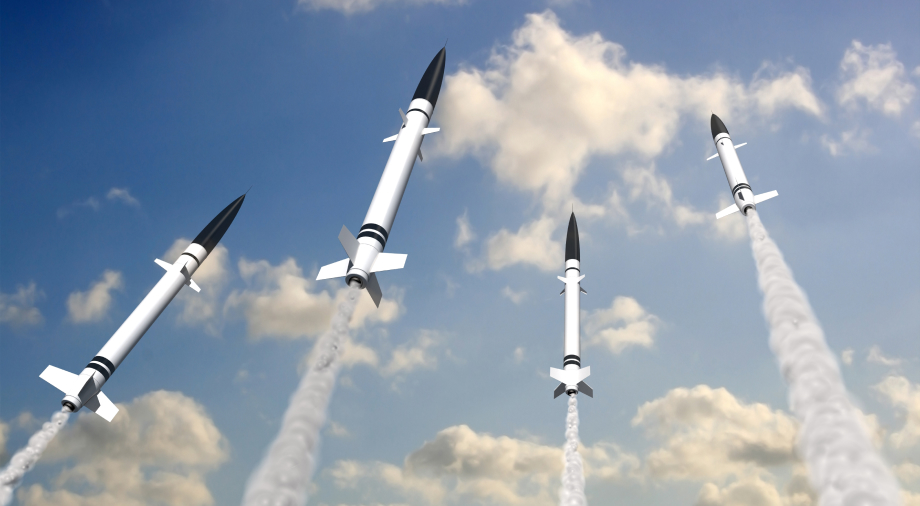The 20th century was the golden age of rocket science. Robert Goddard’s experiments with new liquid propellants allowed his rockets to set a new bar for altitude and speed performance. 20 years later, towards the end of the Second World War, the Germans used his work to create their first supersonic ballistic missiles, with which they delivered devastating blows to London. This is the story of how, in half a century, missiles have gone from a formidable retaliatory weapon in the bloodiest war in history to the main means of preventing it – nuclear deterrence missile forces.
The Experience of Goddard: Forerunner of Ballistic Missiles
Like many scientists of his time, William Goddard, an American physicist and inventor from Massachusetts, began doing rocket experiments in the 1920s. In 1919, the Smithsonian Institution published Goddard’s pioneering work entitled “A Method for Reaching Extreme Altitudes.” Robert’s colleagues were first and foremost interested in the creation of a rocket that could deliver a payload (research equipment) beyond the earth’s atmosphere.
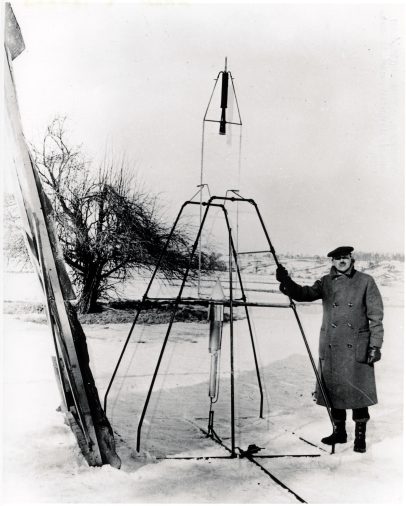
Goddard tried to increase the efficiency of rocket engines, and achieved thisusing a fuel mixture consisting of liquid oxygen and gasoline, as well as using a de Laval rocket nozzle. In addition, he used a a pressurized fuel supply system in his first rockets, which would later allow him to design a rocket with controlled jet propulsion.
On March 16, 1926, Goddard’s first liquid-fuelled rocket launch took place from a makeshift launch site he chose near Worcester, Massachusetts. During launch, the rocket completely used up its fuel supply in 2.5 seconds, but still reached a flight altitude of 41 feet (12.5 m) and a speed of 60 miles / hour (96 km / h). Fearing a leak of technological developments, Goddard never advertised his work, so the successful launch of his innovative rocket did not even make it into the local newspapers. The only witnesses to the event were a few graduate students and researchers from Clark University, as well as the inventor’s wife.
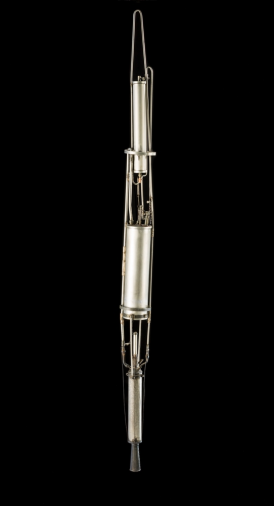
Wanting to take his research to the next level, Robert Goddard began seeking funding for his projects, and in 1930 he found support from American philanthropist and mining magnate Daniel Guggenheim. Goddard entered into an agreement with Guggenheim to finance his work for a period of four years (later extended for another eight years). The inventor’s family moved to Roswell, New Mexico, where Robert Goddard set up a test site to launch new versions of his rockets. However, private investment from the Guggenheim Foundation was clearly not enough to fully demonstrate the military potential of liquid-fuel rockets. For this, Goddard needed the support of the US government, which in the pre-World War II period stubbornly resisted paying attention to the potential of rocket weapons.
Before his own death in 1945, Goddard and his colleagues made another 31 successful launches of their rockets. Later modifications of Robert Goddard’s rockets were equipped with gyroscopes for better orientation in space, and also had payload compartments for scientific equipment. The rocket was aided in its safe return to Earth with a parachute, which was automatically deployed as the rocket descended back to the ground.
Despite a number of innovative engineering solutions, the lack of state interest on the part of the United States did its thankless job, and by the end of the 30s, Nazi Germany had seized the initiative in the field of rocket science. The result was a real evolution of rockets of that time – the first ballistic V-2.
Retribution weapon: German V-2
The first guided ballistic missile in Germany was created with the participation of the talented rocket engineer Wernher von Braun. Von Braun was a member of the Space Flight Society (Verein für Raumschiffahrt), an organization for enthusiasts founded in Germany in 1926. Members of the society managed to find a bureaucratic loophole in the terms of the Treaty of Versailles, which Germany signed at the end of World War I and which forbade the country from developing its own missile program. However, the ban applied only to solid propellant rockets, so the Space Flight Society directed all its efforts to the development of rockets powered by liquid fuel. The German military became interested in the society’s activities.
The first prototype liquid propellant rocket was called the A-2, a miniature rocket powered by a mixture of ethanol fuel and liquid oxygen. It was first successfully launched in December 1934. At the time, von Braun, its designer, was only 22 years old. The success of the A-2 pushed Brown’s team to further develop the A-3 and A-4 versions, which would be similar in size to the future V-2 combat missile.
The V-2 was the world’s first ballistic missile, which meant that its flight took place along a ballistic trajectory, and that its liquid fuel engine was used only during the active phase of the flight as the rocket was launching and climbing. The main engine then switched off, and the rocket flew passively by inertia following its ballistic trajectory. After entering the stratosphere, it was powered on its way down only by gravity, and its flight control was done using an autonomous gyroscopic control system. The rocket was equipped with instruments for measuring speed, along with a software mechanism – a computer that was able to correct the course of the rocket depending on the indicators it received. In total, the V-2 consisted of 3000 components which were designed to function together like clockwork.
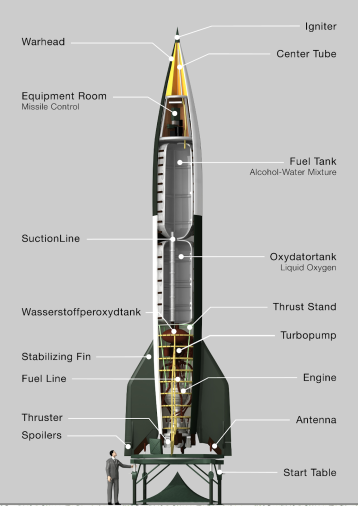
The first launch of the V-2 rocket took place in March 1942 and made a great impression on the military leadership of the Third Reich, which was present at the launch pad. The performance of the later versions of the V-2 is impressive even by today’s standards: the rocket was able to deliver a 980 kg warhead a distance of 320 km, and its cruising speed in suborbital flight reached 5940 km / h (making it the first supersonic missile). During its launch on June 20, 1944, the V-2 reached an altitude of 175 km, making it also the first rocket to reach the boundaries of space.
To launch this 14-ton rocket into suborbital flight, the Germans used a liquid-propellant rocket engine (LPRE) designed by Walter Till, a member of Wernher von Braun’s design team. In the earth’s atmosphere, the Till LPRE designed was able to provide lifting thrust of 25 tons. A large volume of fuel was delivered to the combustion chamber by means of a gas turbine-driven fuel turbopump. The rocket used liquid nitrogen located in cylinders under the turbopump to inject the fuel from its tanks further into the system. Hot steam and oxygen formed due to decomposition of high-quality H2O2 (hydrogen peroxide) by means of a silver catalyst, and these gasses then entered the rocket’s combustion chamber.

In 1943, the V-2 was renamed the “V-2”, or Vergeltungswaffe-2 (translated from German: weapon of retaliation). The new name indirectly testified to the main goals for which the Nazis wanted to use the V-2: to avenge the bombing of German cities by allied aircraft. The first V-2 combat launch was carried out on September 6 on newly-liberated Paris, and the first rocket launches against British territory (specifically London) followed a day later. Until March 27, 1945 (the day of the last combat launch of a V-2), Germany carried out 1359 rocket launches against British territory, of which 1054 rockets reached their targets. Fortunately for the British, V-2’s had rather low accuracy: only half of all missiles fired hit within a 10 km radius of their targets. Nevertheless, the rockets remained a terrible memory for the British: in six months, the rockets claimed 2,724 lives.
After the war, V-2 chief designer Wernher von Braun was saved by his engineering genius. On May 2, 1945, the scientist, together with the surviving part of his team, surrendered to Allied forces in Bavaria, from which they were taken to the United States and involved in the development of the American missile program, which was already pursuing peaceful uses for rockets. Together with a team of 600 other German rocket scientists, von Braun developed the super-heavy Saturn V rocket, which in 1969 carried the first humans to the moon as part of the Apollo 11 mission. The history of the rocket building had made its first turn towards peace.
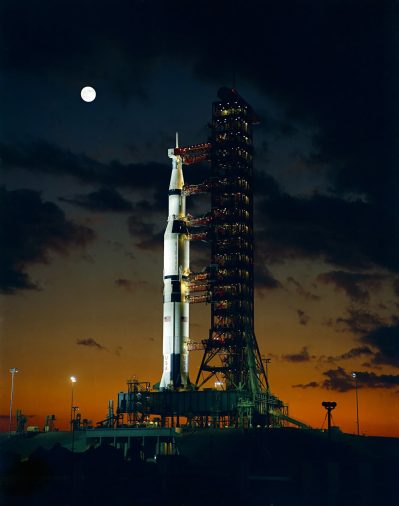
Saturn V rocket on Launch Pad 39, shortly before its first launch on the Apollo 4 mission, November 9, 1967
American rocket engineer Robert Goddard, who in 1945 saw a working copy of the V-2 rocket captured by American troops, was sure that German scientists had stolen its technology, although no evidence of this has yet been found.
Ballistic missiles guarding the modern world
Immediately after the end of World War II, the leaders of the victorious powers were extremely interested in ensuring that conflicts like the world war they had just endured would never happen again in the future. They saw missiles with nuclear warheads as an ideal guarantee of this security.
The United States developed a doctrine of nuclear deterrence. It was based not so much on the direct threat of nuclear missile strikes as on the likelihood that they could be delivered. In other words, ICBMs with nuclear warheads were perceived as defensive weapons, not offensive ones. The doctrine of nuclear deterrence also implied the possibility of delivering nuclear strikes on the territory of the country that was the first to carry out nuclear aggression. Moreover, we are always talking about a symmetrical response in the use of nuclear weapons: for one missile fired, one similar response can follow, and so on.
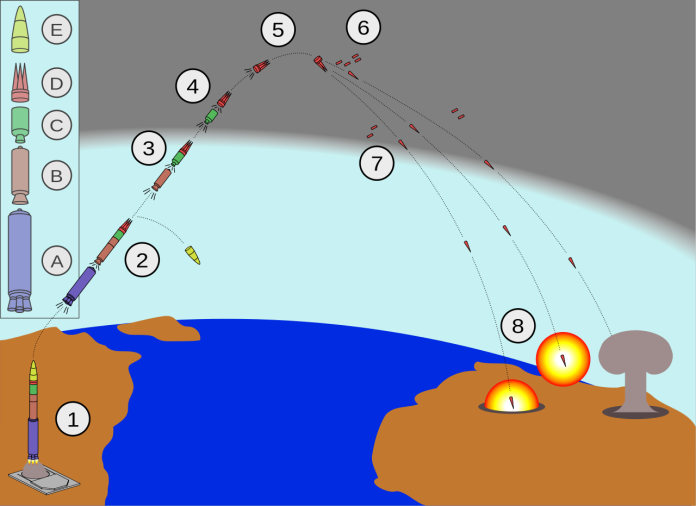
Along with the development of intercontinental ballistic missiles, the world’s leading powers also began to think about the need to protect against them. The result of this was the development of anti-missile defense (ABM), interceptor missiles, the main purpose of which is to track and destroy ballistic missiles at the moment they approach their target.
Enormous funds are being invested in missile defense. For example, between 1950 and 2000 spent more than $117 billion (in 2000 dollars) on the development of missile defense systems. New missile defense systems, together with ever-improving types of intercontinental ballistic missiles capable of delivering nuclear weapons, eventually cooled the ardor of hotheads on both sides of the ocean. In 1972, the US and the USSR concluded the first Strategic Arms Limitation Treaty (SALT-1), in which the Cold War adversaries concluded that “effective measures to limit missile defense systems will lead to a reduction in the risk of war with the use of nuclear weapons.” Later, the SALT-2 treaty (1979) was concluded, as well as three treaties on the reduction of offensive weapons (this time between the United States and Russia), dated 1991, 1993, and 2010.
There are five countries in the world which had their nuclear status grandfathered in during the signing of the Nuclear Non-Proliferation Treaty: the United States, Great Britain, France, Russia and China. There are four NATO members which have agreed to host American nuclear weapons. In addition, there are four countries (plus South Sudan, which was only founded in 2011) which are not parties to the NPT. India and Pakistan never signed the NPT and are both nuclear weapons states, North Korea withdrew from the NPT and developed nuclear weapons, and Israel never signed the treaty but publicly refuses to confirm or deny its possession of a nuclear arsenal (which they are widely known to indeed possess). Iran and Syria have been suspected of having nuclear weapons programs, for which they have been heavily sanctioned by the world community.
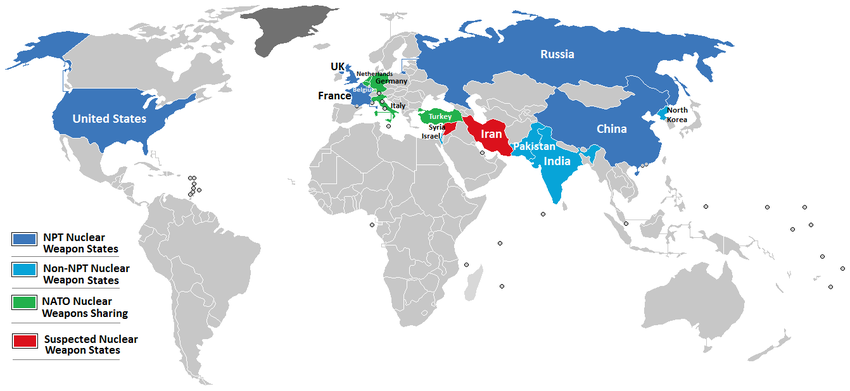
Largely thanks to the doctrine of nuclear parity and deterrence, mankind has not known global wars since the end of World War II. But this solution has had serious drawbacks. The main criticism of the doctrine of nuclear deterrence lies in the growing desire of non-nuclear powers to acquire nuclear weapons in order to guarantee their security on the world stage. These ambitions can provoke an increase in the number of nuclear weapons in the world, and, as a result, the destabilization of world geopolitics. As a result, nuclear deterrence eventually leads to nuclear expansion, endangering global security.Albert Einstein, who was involved in the development of America’s nuclear weapons and well aware of their potential, said of the possible consequences of a global nuclear conflict, “I know not with what weapons World War III will be fought, but World War IV will be fought with sticks and stones.” When the first missile capable of carrying a nuclear warhead appeared, these words became even more poignant.

